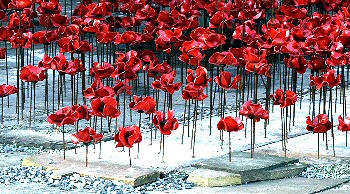|
One Day, Something
Happens - Paintings of People
Image by Lynette Yiadom Boakye.

A new Arts Council Collection
exhibition of paintings of the figure is being exhibited at The Atkinson,
Lord Street, Southport over 20 February 2016 to 22 May 2016, curated by
Jennifer Higgie, co-editor of frieze magazine.
This exhibition reflects a personal view of a period of radical change in
art, from Jennifer Higgie, who herself studied painting. We can see in many
of the paintings the art historical influences felt by the artists but this
unique touring exhibition primarily captures stories and snapshots of lives
past and present. The paintings also convey the theatricality of painting.
By choosing work by the well-known and not so well known, the exhibition
uses the Arts Council Collection to tell a wider story of the twists and
turns of British figurative painting over the past century.
The paintings range from some of the very earliest by date in the Arts
Council Collection, such as the study of a woman by Walter Sickert (1906)
including those and by artists as diverse as Robert Colquhoun (Seated Woman
and Cat, 1946), Prunella Clough (Lowestoft Harbour, 1951), and the Pop
artists Richard Hamilton and David Hockney, who worked from the 1960's. The
present is represented by a group of figurative works by contemporary
artists including Enrico David, Michael Fullerton, David Noonan, Renee So,
Martin Westwood and Lynette Yiadom Boakye.
Jennifer Higgie said:- "What a privilege it was to be asked to curate
an exhibition from the Arts Council Collection. Spending time immersed in
this extraordinary group of over 2000 paintings has been a joy. This
exhibition took shape organically: I realised that the pictures that
particularly attracted me all evoke something theatrical, in the broadest
sense of the word; they also hint at some kind of narrative and their
gestures; however small; are always significant. These wonderful paintings
of people also offer a decidedly idiosyncratic snapshot of over a hundred
years of life in Britain."
Jill Constantine, Head of the Arts Council Collection, said:- "For nearly
70 years, the Arts Council Collection, managed by the Southbank Centre, has
supported artists based in the UK by purchasing their work. The Collection
has been built through the support of the many distinguished artists,
curators and writers who have been invited to advise on the purchase of
works and it is arguably in this very open and democratic approach to
acquisition that the Collection's greatest strength lies. We are delighted
to be working with Jennifer on this exhibition, drawing on her expertise as
a curator and a painter."
All artists in the exhibition will include:- Eileen Agar, Michael Andrews,
Liz Arnold, Walter Bayes, Peter Blake, Glenn Brown, Jeffery Camp, Steve
Claydon, Prunella Clough, Robert Colquhoun, Enrico David, Milena Dragicevic,
Malcolm Drummond, Lucien Freud, Michael Fullerton, Alastair Gray, Roy
Grayson, Richard Hamilton, Georgia Hayes, David Hockney, Donna Huddleston,
Jock McFadyen, Katy Moran, Ryan Mosley, David Noonan, Paula Rego, Ceri
Richards, William Roberts, Bob Robinson, Walter Sickert, Renee So, Euan
Uglow, Peter Unsworth, Phoebe Unwin, Barbara Walker, Martin Westwood, Alfred
Wolmark, Rose Wylie, Lynette Yiadom Boakye.
For more information on the exhibition please call Box Office on:- 01704
533333 or visit:-
TheAtkinson.Co.UK.
Last chance to see
iconic Poppies in Liverpool

THERE is just a week to go for
people to see the beautiful ceramic Poppies in Liverpool. 'The
Poppies - Weeping Window' display had already attracted 301,500
people by the end of 2015, and organisers are expecting thousands more to
head to St George's Hall to see the artwork which encourages people to
remember those who have lost their lives during conflict. The final
time to see the Poppies in the City will be up to 5pm, on Sunday, 17 January
2016, and on this day there will be a short musical accompaniment from the
Liverpool Welsh Choral Union, at 2pm, featuring songs such as:- 'Abide
With Me.' There will also be a poignant close to the art
installation as a bugler from the Band of the Duke of Lancaster's performs
the:- 'Last Post' at around 4.45pm. Throughout, a standard
bearer from the Liverpool Pals Memorial Committee will be present in full
period uniform.

Assistant Mayor and Cabinet Member for
culture, tourism and events, Councillor Wendy Simon, said:- "These
Poppies will have been part of the City's fabric for 72 days and the
reaction to the stunning work has been overwhelming to say the least. We bid
to host the Poppies 6 months ago, as St George's Hall would be the perfect
venue for the installation with its World War One connections, and as with
all our events, we knew that as usual, the people of Liverpool would come
out in their thousands to show support for the thought provoking piece of
work. But we didn't expect the response we've had, and it makes me massively
proud to know so many people have taken the time to visit the Poppies. I'd
like to take this opportunity to thank all the Poppy Ambassadors who gave up
their time and, despite the wind and rain, gave a warm welcome to visitors
being constantly on hand to answer any questions or queries. Their help was
invaluable and they were true ambassadors."
Weeping Window was part of the installation Blood Swept Lands and Seas of
Red which was showcased at HM Tower of London in 2014. It was in
Liverpool as part of a UK wide tour of the poppies organised by 14-18 NOW,
giving people across the UK the chance to experience the impact of the
ceramic poppy sculptures in a range of places with particular First World
War resonance.
Did you know???
The Black Watch Museum
TheBlackWatch.Co.UK, in Perth,
Scotland, will be the next venue to host the Weeping Window. The Museum is
located in Balhousie Castle, on the edge of the North Inch in Perth. It
tells the story of the iconic Black Watch Regiment from 1725. The Battalion
traces its roots from The Black Watch (Royal Highland Regiment) and has a
long and distinguished history dating back to 1739. As it stands today, the
regiment was created under the Childers Reforms of 1881, as the Black Watch
(Royal Highlanders), by the amalgamation of the 42nd (Royal Highland)
Regiment of Foot and the 73rd (Perthshire) Regiment of Foot. As part of the
Scottish Division, it was the senior regiment of the Highland Brigade. More
information about the Regiment see:-
1914-1918.net also see the British Army's
website. |
 |
Historic letters to the
Earls of Derby made public

HISTORIC letters to the Earls of
Derby from members of the Royal Family and other prominent figures have been
made available at Liverpool Central Library for the 1st time, on Thursday, 7
January 2016. A selection of the newly available archive was unveiled by the
present Earl of Derby at a special event in the Hornby Library at Liverpool
Central Library that night.
Thousands of papers, which also include diaries and other documents written
in the 1800's and belonging to the 13th, 14th and 15th Earls of Derby, have
been deciphered over a 20 month period by experienced archivists.
The Earls of Derby, based at Knowsley Hall, have had a significant impact as
national politicians and local magnates and landowners in Lancashire and
later Merseyside, which affected education, hospitals, law, agriculture,
trade and art.
The documents include correspondence from Queen Victoria, Prince Albert, the
Prince of Wales, Horatio Nelson, Edward Lear, the Duke of Wellington,
Charles Darwin, Benjamin Disraeli, William Gladstone, Catherine Gladstone,
Florence Nightingale and Herbert Spencer.

The letters are now catalogued in detail
and fully accessible at Liverpool Record Office in Central Library and also
available and searchable online.
Assistant Mayor and Cabinet member for culture, Councillor Wendy Simon,
said:- "This collection is a significant snapshot of our history,
giving a fascinating insight into the world of some of the most famous and
influential people of the 19th Century. I am delighted that thanks to the
work of our archivists, we are now able to make the papers available to
people who wish to view them, whether it's in person or online."
The event also launch a new publication on the history of the Earls:-
'Art, Animals and Politics.' 'Knowsley and the Earls of Derby' was
edited by Dr Stephen Lloyd, Curator of the Derby Collection and published by
Unicorn Press Ltd. It includes absorbing essays by a distinguished cast of
contributors led by historian David Starkey, writing about the political
significance of Lady Margaret Beaufort, the 1st Countess of Derby, and
broadcaster Sir David Attenborough, on Edward Lear's zoological drawings,
many of which were made at Knowsley.
It covers key facets of the family's diverse achievements. Thomas, Lord
Stanley, was created Earl of Derby in 1485 after the Battle of Bosworth
Field. Since that time the Stanleys; a great Lancastrian family, whose seat,
Knowsley Hall, is near Liverpool; have been significant in the life of the
nation as patrons and collectors, sportsmen and politicians.

The project and catalogue was produced
with support from the National Cataloguing Grants Programme for Archive
administered by The National Archives.
People wishing to access the original Derby Papers can make a booking at
the:- Liverpool Record Office, 3rd Floor, Central Library, William Brown
Street, Liverpool L3 8EW. They can also call:- 0151 233 3069 or send an
email to:-
archives@liverpool.gov.uk.
The Search Room is open from 9.30am to 6pm Monday, Tuesday, Thursday and
Friday, also on Wednesday's from 9.30am to 8pm and from 9.30am to 5pm on
Saturday.
The catalogue is also available
online now.
Did you know?
► The 13th Earl, Edward Smith Stanley was a naturalist, a patron of Edward
Lear and John James Audubon, President of the Linnaean Society and President
of the London (Royal) Zoological Society. He bequeathed his 15,000 museum
specimens to Liverpool and became the core of the natural history collection
in what became Liverpool Museum, now World Museum Liverpool, still available
to view today.
► The 14th Earl, Edward Geoffrey Stanley inherited the title in 1851, and
served as Prime Minister three times, responsible for some of the major
reforms of the 19th century. He oversaw the Government of India Act which
transferred control from the East India Company to the British Crown in
1858, leading to the Raj and oversaw the Jews Relief Act which ended the
exclusion of Jews from seats in Parliament. In 1867 his government passed
the Reform Act, which allowed working men to vote for the 1st time. As an MP
he had introduced the Irish Education Act in 1831 and had a role in the
Abolition of Slavery Act in 1834. The 14th Earl had worked to alleviate the
distress of the textile workers in Lancashire, many of whom were his
tenants, during the American Civil War.
► The 15th Earl of Derby, Edward Henry Stanley inherited the title in 1869
and was also a prominent politician. He served under his father as Secretary
of State for the Colonies, for India and for Foreign Affairs. He left 33
diaries giving great insight into his personal and public life. He donated
land that became Stanley Hospital in Kirkdale and Bootle Hospital in Derby
Road and also donated parkland in the area. He supported many educational
schemes, including Schools in deprived areas and contributed significantly
to the funding of the beginnings of the University of Liverpool and
University of Manchester.
|
















